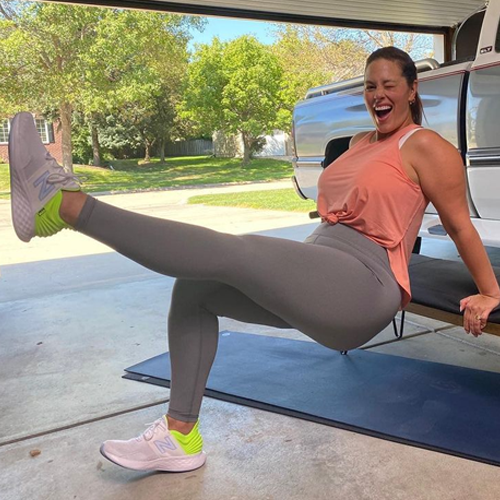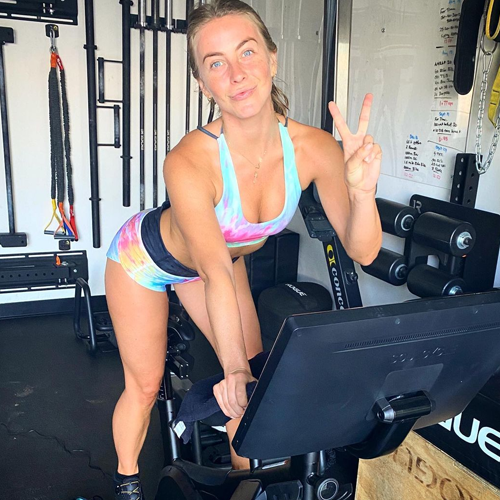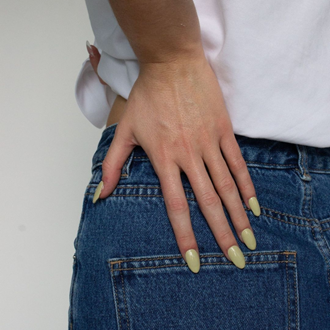Why spring should serve as the start of your wellness year

By Delaney Loane
Digital Beauty Editor / March 31 2022

Trust us, January ain’t got nothing on now

By Delaney Loane
Digital Beauty Editor / March 31 2022
Ah, New Year’s resolutions. They’re fun to make; therapeutic even. Because honestly, while nursing a New Year’s Eve hangover, ‘no drinking’ will always sound like a stellar idea. Trying to stick to them, however, is not fun. It’s not always possible either. We swear we’ve tried.
And yet, for some reason, we still promise to be different every year. They’re often the same (hollow) promises we made the year before too; eat better, exercise often, meditate more, drink less, etc. Seriously, why do we love setting ourselves up for failure so much?
Take the alcohol-free option, for example: maybe you throw back multiple wines on December 31st, swear you’ll be a beacon of sobriety come January 1st, but then dive into the poolside cocktails mere hours later (because, well, it’s January 1st for crying out loud). Is that really a heinous crime? No.
Charlie didn’t set himself a ‘no sweets’ rule on his way to Wonka’s factory, now did he? Our point? Party season is a time of major temptation – food and alcohol are practically synonymous with Christmas. The holidays are supposed to serve as a time of celebration, not restriction, after all.
The cruel kicker, however, is that while most of the world can stay snug and smug in cosy/hideous festive knits, us Aussies are celebrating (and let’s be honest, gorging) at a time of year when our bodies are on show the most. It’s sweltering in summer; you try wearing a sweater.
So how does one set realistic resolutions? Well, it’s actually as much about the ‘when’ as the ‘how’. We’re not advising you to do away with resolutions altogether; hell, it’s fun to imagine our ‘best’ selves thriving. We’re just suggesting a little timing tweak.
Our tip? Swap summer resolutions for spring ones instead. You’ll feel fitter, happier and healthier come Christmastime, and you won’t experience immense pressure to stop enjoying yourself the minute the calendar ticks over to January.
Yes indeed, it’s time to make spring the start of your wellness year. Need more convincing? We spoke to the experts to find out why said switch may just be the secret to resolution-related success..

@lanacondor
Why resolution timing matters
“The festive season (Christmas and New Year’s) carries an increased sense of temptation,” explains Lysn psychologist Nancy Sokarno. “We often are very focused on the outlook of ‘eat, drink and be merry’ so it can be really hard to restrain ourselves from the temptation that that time brings.”
“It’s harder to stop ourselves from indulging when you’re exposed to things like Christmas lunches and it’s harder to exercise when it seems like everyone else is winding down and relaxing,” she continues.
“Funnily enough, research suggests that only 8 per cent of people actually achieve their New Year’s goals,” Sokarno adds. “That’s a pretty incredible statistic and shows that for many of us, New Year’s resolutions are closer to [mere] hopefulness than something we achieve.”
“New Year’s Day is a tough day to start a new life plan, or stick to hardcore diet and exercise goals,” echoes Simonne Reynolds FACP, Specialist Sports Physiotherapist and Director of Spooner Specialist Physiotherapy in Gladesville. “Many of us are still on holidays, catching up with friends and celebrating the festive season over summer, so sticking to strict extinction diets and daily exercise routines can be difficult. Depriving your body of pleasure will just lead to cravings.” And that’s on Christmas ham.
“Spring [on the other hand], by its very nature, signals energy and growth,” says Reynolds. “The days are warmer and longer, encouraging us outside to move and enjoy the sunshine. The warmer days naturally encourage us away from heavy, ‘comfort’ food, which we often seek out to feed the soul in the dark, cold, winter months.”
“Spring is a time of ' new beginnings’; lighter, longer days with more energy and spending more time outside,” agrees Jess Blair, Duke the Label’s Nutritionist and Naturopath. “[It’s a period of] ‘spring cleaning’ our lives so it is a great time to start a new goal and set some new intentions that can [actually] work out this wonderful time of year.”

@camimendes
How to frame the resolution setting process
First, let’s get one thing straight: once you’ve adjusted your timing, wellness resolutions can indeed be incredible for your mental and physical health. “Setting goals can offer up a ‘clean slate’ where we can decide to do things a little differently,” confirms Reynolds. “Goal setting can be motivating because it allows us to work on all aspects of our lives and with it comes the promise of new beginnings and positive changes.”
There’s one overall theme you should keep in mind when setting your goals, though: “Be realistic,” says Sokarno. “[It’s] perhaps the most important tip and often the reason why many people fail in achieving their New Year’s resolutions.”
“Be realistic about what you can achieve and choose goals that are attainable. Whilst it’s great to set the bar high, you have to be truthful with yourself and ask if it is something you can realistically do. Yes, it is worth being optimistic, but evidence shows we are more likely to be committed to achieving our goals if we believe they are attainable,” she shares.
Sokarno’s next rule? “Less is more. Rather than writing out a list of 30 goals and being disappointed when you don’t achieve all of them, pick a couple of goals instead.” “Too many goals can leave you feeling overwhelmed with your to-do list and stops you from being laser focused with the goals that matter the most,” Sokarno explains. “Whilst it’s admirable to want to achieve a lot, start out with a smaller list and add to it as you tick things off!”
“Try breaking down your goals into more bite size pieces or ‘subgoals’. Sometimes larger or grand goals can feel out of reach because it’s hard to see how we can get there. In fact, working with ‘subgoals’ has been shown to increase self-confidence and motivation because we are able to see results quickly and our gradual progress towards the overall goal,” says Sokarno.
“Establish goals that are small yet specific, achievable, motivating and realistic,” agrees Reynolds. “The aim is to not try to overwhelm ourselves and to pick goals that are relevant and of benefit to us!”

@keke
How to come up with your actual goals
‘Wellness’ is of course a wildly broad category, that envelops every kind of ‘health’ from mental to physical and spiritual and emotional. So, to get started, let’s break down a few major sectors that wellness goals often revolve around: exercise, mindfulness and diet (but no, not in a scary ‘no cheese ‘til June’ way; rather in a ‘putting premium fuel into your body’ one).
Diet
“My philosophies around food are about adding things into your life rather than taking things away,” explains Blair. “So, if someone wanted to start a new goal, instead of saying no coffee, no chocolate, (which would be hard right?!) I would say let's concentrate this week on drinking enough water, and let's add some movement into your day, and let's add some ' joy' into your day.”
“I think that having your main goal be around health is the best way to go when you want to start on your journey,” Blair advises. “Remember that health is more than what we look like, so focusing a goal solely on a weight number doesn't equate to health. We have to think of our health as everything we do; yes, food is included but sleep is just as important, so is our mental health, spiritual and emotional health.”
“The first thing I would do is to limit alcohol,” she suggests. “Alcohol can have some serious consequences on our sleep, on our mood and on our overall health, so if you want to do one thing to start the process after lockdown, my advice would be limit the alcohol!” While this is obviously a great goal, we would also like to remind you that yes, there is a brief pass for party season.
“Start slow, too – easing in will help you to play and win the long game,” adds Reynolds. “A good example of this might be a meat eater who decides to go vegan – don’t do it cold turkey (pardon the pun)! Try a phased approach and start out with meat-free days or meat-free meals each week and work your way to being vegan. This way it’s not going to be such a shock to the mind and body and it will be easier to achieve.”
Anyone who’s ever tried to go from multiple pavlovas per day in December to zero sugar in January will be happy to hear that, we’re sure.

@laisribeiro
Exercise
“Like all goals, our exercise resolutions need to be challenging, yet achievable, but also meaningful,” Reynolds explains re: workout goals. “We need to know not just our what, but our ‘why’. Do you want to be fitter, lose weight, or be healthier? All are very admirable goals, but the ‘why’ makes these goals matter.”
“Do you want to be a role model for your kids? Do you want to reduce the risks of serious health conditions? Do you want to feel sexy in your own skin? Knowing WHY you want to make your changes makes it easier to take that step out the door every day to get your exercise done,” she explains.
Remember that exercise is meant to be a way to take care of yourself, too; not just a torturous bother. It is possible that there’s still a form of exercise out there that you’ll like; you just may have to kiss a few metaphorical frogs first.
“It’s incredibly important to enjoy the process,” Reynolds confirms. “If you don’t like running, don’t do it just because you saw someone on social media who said it’s great for weight loss. If you can find something you actually enjoy doing, it will make it so much easier to commit to your new routine.”
As for the ‘amount’ you should be trying to commit to, it will of course depend on personal factors (such as your goal, your current fitness level, past injuries, etc.), but as a general rule, Reynolds notes that “the World Health Organisation recommends between 150 – 300 minutes of moderate intensity exercise per week.”
“This equates to 20 – 45 minutes a day. You don’t have to pound the pavement for hours to make effective changes to your health,” she says. In fact, Reynolds is all about a balanced approach to exercise, even if your goals are lofty. “Remember, our adaptations to exercise occur during our rest and recovery. Rest days are not lazy days; they are important stepping stones to the overall positive health journey we have begun,” she explains.
“I see so many people in my clinic who have engaged in a new exercise program and gone too hard too soon, which almost always results in injury,” she says. “It is important to remember to only change one FITT parameter at a time. These are Frequency, Intensity, Time and Type. If you want to increase how long you run, walk or swim, you shouldn't try to also run more quickly. You should feel comfortable at your increased level of loading, before you increase any of these parameters.”
Reynolds also suggests using the buddy system to keep you on track. “Accountability holds us all to our commitments,” she says. “So grab a friend to exercise with you and track your workouts and progress on the parameters important to you (weight, distance walked, clothing size, sleep quality, energy levels), so you can look back and see how far you have come.”

@ashleygraham
Mindfulness
Try not to limit your resolutions to solely physical health-related ones, either – mental ‘fitness’ is incredibly important, and should be at least equally as much of a priority on your goals list. Not sure where to start? Sokarno has some suggestions.
“Practicing gratitude is a really great habit to get into because it can help to put things into perspective and allow you to realise what is important,” she says. “Much of the time, we can take for granted the good things in our life. Take time out of your day/week to actively reflect on what you are grateful for. This can shift your attention to the positive, lift your mood and get you through tough times.” FYI, a good gratitude journal is like a chic set of activewear; having the gear is sometimes all the motivation you need.
Of course, some mental wellness activities can still be tied to physical ones – two birds, one stone, right? “Practicing mindfulness activities such as meditation, breathing exercises and yoga are great goals for anyone’s wellbeing,” says Sokarno. “Whilst these types of practices might not be the norm for you, you can try a phased approach by doing it once a week and work your way up to what’s comfortable.”
Another strategy you can try? Switching up your self-talk. Try and treat yourself like one of your loved ones; you wouldn’t say cruel things about them (we hope), so why do it to yourself? “Practicing positive affirmations is also a popular technique which is sometimes used in Cognitive Behavioural Therapy,” Sokarno shares. “Positive affirmations are the process of trying to train your brain into believing a statement that you’re saying (even if you would naturally go against that thought) and stopping that negative inner voice.”
“The idea is to focus on replacing any existing negative or detrimental thoughts, with thoughts that positively affirm one’s self-worth. Practicing positive affirmations can help for people who might generally have a negative disposition or a low self-image.”
Say it with us: we are spectacular, and we will achieve our goals.

@nina
How to keep yourself motivated
Of course, while spring is no doubt an easier and more realistic time to start your journey, setbacks and loss of motivation may still occur. “Make sure you are celebrating the wins and rewarding yourself when you achieve goals or milestones,” suggests Reynolds.
“This is important because our brains react positively to rewards and if you do this continually, your brain will link pleasure with achieving goals,” she explains, noting that the achieve-and-celebrate strategy works particularly well alongside a ‘subgoal’ one. “If you’ve broken down your goals into smaller, more achievable actions and you’re consistently ticking them off, take some time to pat yourself on the back. Giving yourself a reward helps with motivation, however, make sure that it is consistent with what you’re trying to achieve.”
In other words, if your goal was to cut out dairy for digestive reasons, rewarding yourself with a giant ice cream sundae may not be the answer. Try and come up with something that feels celebratory but doesn’t alter your original path too much.

@juleshough
How to (kindly) cope with setbacks
Missing the mark on a milestone is no reason to undo all the mental health training you’ve been doing, either. Sokarno has some advice for dealing with the dreaded sense of resolution-related ‘failure’ we’re all too familiar with…
“If you worked hard but didn’t achieve it, still congratulate yourself anyway! The fact that you put the work in should be plenty to celebrate and shows you can be dedicated,” she explains. “There are so many reasons why you may not have achieved it (especially this year)! So go easy on yourself and keep working towards that goal.”
“If you didn’t stick to your goal, again, go easy on yourself. This year was particularly tough so it’s important to recognise that and be kinder to yourself. If those goals are important to you, keep at it! Perhaps just take another look at the goals and any parameters you’ve set and decide if you need to readjust things like time frames or whether it could be broken down to smaller goals.”
“I think we have all been through a crazy two years, and we need to really pick our battles,” echoes Blair. “I think gradual is always the way to go, but also, if that piece of cake is giving you some comfort in a very uncomfortable time, I say eat the cake!”
“Remind yourself that you are human and it is okay to make mistakes or deter from a dedicated path every once in a while,” says Sokarno. “The key here is to not let it deter you from trying again. For example, if your goal is to give up drinking but you have a glass of champagne to celebrate your friend’s engagement, that doesn’t mean you need to beat yourself up and decide that you’re not going to bother with your goal. Falling off track a little doesn’t mean you then have to start from scratch, it’s just a bump in the road and it’s better to keep going rather than give up altogether.”
Long story short, try to focus on how far you’ve come – it’ll remind you that you can achieve your goal if you just keep chipping away, you resilient thing, you.

@kateupton
How often to readjust wellness goals
As for the future, how frequently should you reassess? “The healthy approach is what works best for you!” Reynolds shares. “Everyone operates and responds to different approaches so it’s important to analyse how you work best. Seasonal revisions, [however, generally] seem like a good time frame and will allow you to factor in any elements that could affect your goals moving forward.”
Makes sense; we do like to blame things on the weather. But for now, spring has got ‘fresh start’ written all over it.
Main image credits: @ashleygraham, @jastookes, @selenagomez, @lizzobeeating, @kateupton, @leamichele
Want more inspiring features like this? Read the rest of our digital issue.






